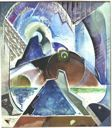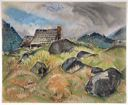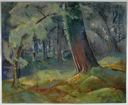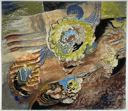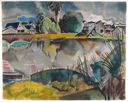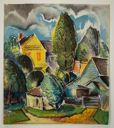Will Henry Stevens
American
(Vevay, Indiana, 1881 - 1949, Vevay, Indiana)
Will Henry Stevens was born on November 28, 1881, and became a leading American artist working through the mid-twentieth century. (1) Initially living in the Ohio River Valley and later in New Orleans, Louisiana along the Mississippi River, Stevens’ work reveals his life-long love of nature. His career reflects his search to know and understand nature as he was always committed to observing, experiencing, and connecting to nature.
From an early age, Stevens showed an aptitude for art. He began studying art, in particular drawing, around 1891, when he trained with a local artist in Indiana. (2) Although Stevens’ studies initially focused on drawing, his attention quickly shifted to painting. He went on to enroll at the Cincinnati Art Academy in 1901, and for the next three years, he worked under Frank Duveneck of America's Munich School. (3) However, the Academy’s studio structure proved to be a struggle for Stevens, and he did not take a fourth and final year at the Cincinnati Art Academy. Rather, he took up work as both a designer and a painter with Rookwood Pottery, a leading arts and crafts manufacturer, in 1905. (4) Stevens worked specifically with decorative ceramics, and his success soon led to projects in New York, (5) where he went in 1906. He continued to work with Rookwood Pottery during his first year or so in New York City but was distanced from the arts and crafts house by 1908. Concurrently, Stevens resumed his academic courses in New York City, studying at the Art Students League under William Merritt Chase, a famous American Impressionist. (6) Still, Stevens did not take to the structured learning environment, and he left the Art Students League shortly after enrolling.
Throughout his formative years, Stevens was less affected by the traditional scholarship found at the Cincinnati Art Academy or the Art Students League than by his own interests. Stevens’ appreciation of nature led him to the philosophies of Ralph Waldo Emerson, Henry David Thoreau, and Walt Whitman (7) during his youth. Thus, his artistic direction emerged primarily from this profound love of nature, and his choice of subject matter guided the development of his style into representations of his more or less spiritual interactions with nature.
As a young painter, Stevens was associated with Mary Bacon Ford’s New Gallery in New York City. (8) There, he exhibited his early works as well as met artists Albert Pinkham Ryder, Van Dearing Perrine, and Jonas Lie, all of whom were struck by Stevens’ work. Notably, Perrine and Lie were progressive influences on Stevens as he matured; they encouraged his individual vision in addition to sharing his interest in nature, and together, Stevens, Perrine, and Lie participated in group exhibitions at the New Gallery.
Between 1912 and 1922, Stevens spent time traveling, painting, and exhibiting in the Midwest. While he recorded his home as Vevay, Indiana, he listed his current address as Louisville, Kentucky, and yet, he visited New York City annually, often staying for several months. (9) In addition, he traveled elsewhere, as far as the Smoky Mountains in North Carolina, for summers. This peripatetic existence lends to the expansion of the influences on his work, directly and indirectly, because not only was he traversing a variety of landscapes, he was also experiencing a variety of art forms.
Around 1912, Stevens’s travels took him through Washington, D.C. and its Freer Gallery, which showcased Oriental art. (10) From Japanese folding screens to Korean ceramics, Stevens was most moved by the Chinese paintings of the Sung Dynasty (960 and 1279 AD). He was inspired by the Chinese aesthetic seen in the landscapes, and he recalled, “Here I found the thing that I had been aware of in nature. I could not look at Sung without realizing it had the same kind of philosophy that I had discovered in Walt Whitman. The experience sank deep…” (11) He subsequently sought more information on Oriental art and its philosophy. Essentially, Stevens found an artistic equivalent to the literary philosophies of American transcendentalism, and this had a lasting influence. Stevens merged his understanding of the two viewpoints into his own work; (12) he adopted the idea that the artist and his art are merely extensions of nature, concluding, “The best thing a human can do in life is to get rid of his separateness or selfishness and hand himself over to the nature of things – to this mysterious thing called the Universal Order, that any artist must sense.” (13)
Sometime in 1926 or 1927, Stevens attended exhibitions of modern art held at the Brooklyn and Guggenheim Museums in New York. He saw large showings of non-objective works by Wassily Kandinsky (1866-1944, Russian) and Paul Klee (1879-1940, German). (14) Stevens responded to the abstract qualities of their works much as he had with the Sung Dynasty paintings. The spiritual sensibilities of modern art appealed to Stevens; he saw the exploitation of line, form, and color as powerfully expressive. Bernard Lemann, a friend and colleague of Stevens, recalled, “It was evident…that [Stevens] was interested in the…aspects of vision, and that he was beginning at this time to give ever more thought to the element of abstract design in painting.” (15) This confirmed Steven’s artistic direction towards abstraction as a means of recording his engagement with nature.
By 1921, Stevens’ talent had earned him an appointment to art faculty of Newcomb College (today, part of Tulane University) in New Orleans, Louisiana. (16) He taught his first classes that winter and remained there until his retirement in 1948. The Newcomb Art Department gave Stevens a large degree of freedom in his teaching commitments and Stevens took advantage of this flexibility for his own art’s sake. He continued to travel frequently in addition to painting and exhibiting at the same rate.
Stevens worked to combine the spirituality he felt in the paintings from the Sung Dynasty with the expressiveness he saw in the paintings by Kandinsky and Klee. Stevens devoted himself and his art to presenting the essence of nature, and he sought to do so by portraying the artist, artwork, and actual subject as one. He often worked directly from nature, which reinforced his sense of personal involvement. Stevens said, “A painter would go far to find a richer field but to paint it one must love it. For my part, I must feel rooted to a place, a sort of ownership in it, or I cannot take the expression of it seriously.” (17) He was both thoughtful and purposeful in his techniques, and interestingly, he worked simultaneously in two styles - one, objective and then other, non-objective. While it is curious that Stevens would work in two seemingly incongruous styles, he insisted, “…I am doing both and will continue to, so long as either seems vital to me. ” (18) His objective and non-objective work show equal talent and craftsmanship. Through the use of both forms of representation, Stevens depicted the harmony and truth he felt in nature. Although he always maintained the essential elements of design, form, and color in his more representational as well as his less representational works, his most successful paintings and drawings combined the two styles. The results were powerful, imaginary interpretations of the various landscapes Stevens presented.
From his early work to his late career, Stevens participated in and contributed greatly to the regionalist and modernist art movements. He worked to portray the sense of place he felt within his world. Stevens’ art speaks to his belief in the importance of intimate emotions and universal truths. Stevens died in his hometown of Vevay, Indiana in 1949.
(1) Poesch, Jessie. Will Henry Stevens. 7. (2) It should be noted that Stevens was casual about recording dates many of the dates given are estimates gathered from files, newspapers, catalogs, etc. Poesch, Jessie. Will Henry Stevens. 8
(3) Poesch, Jessie. Will Henry Stevens. 8. (4) Poesch, Jessie. Will Henry Stevens. 8. (5) Stevens is responsible to designing the ceramic panels at the Sinton Hotel in Cincinnati, Ohio and the Hotel Breslin Rathskeller in New York City as well as the subway tiles for the Wall Street and Fulton Street stations. Poesch, Jessie. Will Henry Stevens. 9. (6) Poesch, Jessie. Will Henry Stevens. 11. (7) Pennington, Estill Curtis. Will Henry Stevens: An eyes transformed, a hand transforming… 10. (8) Poesch, Jessie. Will Henry Stevens. 11.
(9) Poesch, Jessie. Will Henry Stevens. 12. (10) Poesch, Jessie. Will Henry Stevens. 12. (11) Poesch, Jessie. Will Henry Stevens. 12. (12) It should be noted that Stevens did not immediately incorporate the Oriental influences into his art. His recollection continued, “…it did not influence me directly in my work for some time.” Poesch, Jessie. Will Henry Stevens. 12. (13) Chambers, Bruce W. “Will Henry Stevens,” in Art and Artists of the South. 145. (14) Poesch, Jessie. Will Henry Stevens. 12. (15) Lemann, Bernard. Will Henry’s Nature: The Pictorial Ideas of W.H. Stevens.” 1947-48. 54-55. (16) Prior to signing with Newcomb College, Stevens supported himself and his family by conducting public and private art classes in whatever location he found himself from Louisville, Kentucky to Valley Town, North Carolina. Poesch, Jessie. Will Henry Stevens. 16.
(17) See Ogden Museum website, www.ogdenmuseum.org/education/unit_plan-will-henry-stevens.pdf (18) Unlike most artists, Stevens continued to paint realistically and abstractly; he was not exclusively about his subjects and techniques. Stevens said, “ What I have liked in nonobjective is, for me, the new experience in design I am permitted when I do not have to tie everything to a base, as in objective painting. Anyway, I am doing both and will continue to, so long as either seems vital to me.” Lemann, Bernard. Will Henry’s Nature: The Pictorial Ideas of W.H. Stevens.” 58-59.
American
(Vevay, Indiana, 1881 - 1949, Vevay, Indiana)
Will Henry Stevens was born on November 28, 1881, and became a leading American artist working through the mid-twentieth century. (1) Initially living in the Ohio River Valley and later in New Orleans, Louisiana along the Mississippi River, Stevens’ work reveals his life-long love of nature. His career reflects his search to know and understand nature as he was always committed to observing, experiencing, and connecting to nature.
From an early age, Stevens showed an aptitude for art. He began studying art, in particular drawing, around 1891, when he trained with a local artist in Indiana. (2) Although Stevens’ studies initially focused on drawing, his attention quickly shifted to painting. He went on to enroll at the Cincinnati Art Academy in 1901, and for the next three years, he worked under Frank Duveneck of America's Munich School. (3) However, the Academy’s studio structure proved to be a struggle for Stevens, and he did not take a fourth and final year at the Cincinnati Art Academy. Rather, he took up work as both a designer and a painter with Rookwood Pottery, a leading arts and crafts manufacturer, in 1905. (4) Stevens worked specifically with decorative ceramics, and his success soon led to projects in New York, (5) where he went in 1906. He continued to work with Rookwood Pottery during his first year or so in New York City but was distanced from the arts and crafts house by 1908. Concurrently, Stevens resumed his academic courses in New York City, studying at the Art Students League under William Merritt Chase, a famous American Impressionist. (6) Still, Stevens did not take to the structured learning environment, and he left the Art Students League shortly after enrolling.
Throughout his formative years, Stevens was less affected by the traditional scholarship found at the Cincinnati Art Academy or the Art Students League than by his own interests. Stevens’ appreciation of nature led him to the philosophies of Ralph Waldo Emerson, Henry David Thoreau, and Walt Whitman (7) during his youth. Thus, his artistic direction emerged primarily from this profound love of nature, and his choice of subject matter guided the development of his style into representations of his more or less spiritual interactions with nature.
As a young painter, Stevens was associated with Mary Bacon Ford’s New Gallery in New York City. (8) There, he exhibited his early works as well as met artists Albert Pinkham Ryder, Van Dearing Perrine, and Jonas Lie, all of whom were struck by Stevens’ work. Notably, Perrine and Lie were progressive influences on Stevens as he matured; they encouraged his individual vision in addition to sharing his interest in nature, and together, Stevens, Perrine, and Lie participated in group exhibitions at the New Gallery.
Between 1912 and 1922, Stevens spent time traveling, painting, and exhibiting in the Midwest. While he recorded his home as Vevay, Indiana, he listed his current address as Louisville, Kentucky, and yet, he visited New York City annually, often staying for several months. (9) In addition, he traveled elsewhere, as far as the Smoky Mountains in North Carolina, for summers. This peripatetic existence lends to the expansion of the influences on his work, directly and indirectly, because not only was he traversing a variety of landscapes, he was also experiencing a variety of art forms.
Around 1912, Stevens’s travels took him through Washington, D.C. and its Freer Gallery, which showcased Oriental art. (10) From Japanese folding screens to Korean ceramics, Stevens was most moved by the Chinese paintings of the Sung Dynasty (960 and 1279 AD). He was inspired by the Chinese aesthetic seen in the landscapes, and he recalled, “Here I found the thing that I had been aware of in nature. I could not look at Sung without realizing it had the same kind of philosophy that I had discovered in Walt Whitman. The experience sank deep…” (11) He subsequently sought more information on Oriental art and its philosophy. Essentially, Stevens found an artistic equivalent to the literary philosophies of American transcendentalism, and this had a lasting influence. Stevens merged his understanding of the two viewpoints into his own work; (12) he adopted the idea that the artist and his art are merely extensions of nature, concluding, “The best thing a human can do in life is to get rid of his separateness or selfishness and hand himself over to the nature of things – to this mysterious thing called the Universal Order, that any artist must sense.” (13)
Sometime in 1926 or 1927, Stevens attended exhibitions of modern art held at the Brooklyn and Guggenheim Museums in New York. He saw large showings of non-objective works by Wassily Kandinsky (1866-1944, Russian) and Paul Klee (1879-1940, German). (14) Stevens responded to the abstract qualities of their works much as he had with the Sung Dynasty paintings. The spiritual sensibilities of modern art appealed to Stevens; he saw the exploitation of line, form, and color as powerfully expressive. Bernard Lemann, a friend and colleague of Stevens, recalled, “It was evident…that [Stevens] was interested in the…aspects of vision, and that he was beginning at this time to give ever more thought to the element of abstract design in painting.” (15) This confirmed Steven’s artistic direction towards abstraction as a means of recording his engagement with nature.
By 1921, Stevens’ talent had earned him an appointment to art faculty of Newcomb College (today, part of Tulane University) in New Orleans, Louisiana. (16) He taught his first classes that winter and remained there until his retirement in 1948. The Newcomb Art Department gave Stevens a large degree of freedom in his teaching commitments and Stevens took advantage of this flexibility for his own art’s sake. He continued to travel frequently in addition to painting and exhibiting at the same rate.
Stevens worked to combine the spirituality he felt in the paintings from the Sung Dynasty with the expressiveness he saw in the paintings by Kandinsky and Klee. Stevens devoted himself and his art to presenting the essence of nature, and he sought to do so by portraying the artist, artwork, and actual subject as one. He often worked directly from nature, which reinforced his sense of personal involvement. Stevens said, “A painter would go far to find a richer field but to paint it one must love it. For my part, I must feel rooted to a place, a sort of ownership in it, or I cannot take the expression of it seriously.” (17) He was both thoughtful and purposeful in his techniques, and interestingly, he worked simultaneously in two styles - one, objective and then other, non-objective. While it is curious that Stevens would work in two seemingly incongruous styles, he insisted, “…I am doing both and will continue to, so long as either seems vital to me. ” (18) His objective and non-objective work show equal talent and craftsmanship. Through the use of both forms of representation, Stevens depicted the harmony and truth he felt in nature. Although he always maintained the essential elements of design, form, and color in his more representational as well as his less representational works, his most successful paintings and drawings combined the two styles. The results were powerful, imaginary interpretations of the various landscapes Stevens presented.
From his early work to his late career, Stevens participated in and contributed greatly to the regionalist and modernist art movements. He worked to portray the sense of place he felt within his world. Stevens’ art speaks to his belief in the importance of intimate emotions and universal truths. Stevens died in his hometown of Vevay, Indiana in 1949.
(1) Poesch, Jessie. Will Henry Stevens. 7. (2) It should be noted that Stevens was casual about recording dates many of the dates given are estimates gathered from files, newspapers, catalogs, etc. Poesch, Jessie. Will Henry Stevens. 8
(3) Poesch, Jessie. Will Henry Stevens. 8. (4) Poesch, Jessie. Will Henry Stevens. 8. (5) Stevens is responsible to designing the ceramic panels at the Sinton Hotel in Cincinnati, Ohio and the Hotel Breslin Rathskeller in New York City as well as the subway tiles for the Wall Street and Fulton Street stations. Poesch, Jessie. Will Henry Stevens. 9. (6) Poesch, Jessie. Will Henry Stevens. 11. (7) Pennington, Estill Curtis. Will Henry Stevens: An eyes transformed, a hand transforming… 10. (8) Poesch, Jessie. Will Henry Stevens. 11.
(9) Poesch, Jessie. Will Henry Stevens. 12. (10) Poesch, Jessie. Will Henry Stevens. 12. (11) Poesch, Jessie. Will Henry Stevens. 12. (12) It should be noted that Stevens did not immediately incorporate the Oriental influences into his art. His recollection continued, “…it did not influence me directly in my work for some time.” Poesch, Jessie. Will Henry Stevens. 12. (13) Chambers, Bruce W. “Will Henry Stevens,” in Art and Artists of the South. 145. (14) Poesch, Jessie. Will Henry Stevens. 12. (15) Lemann, Bernard. Will Henry’s Nature: The Pictorial Ideas of W.H. Stevens.” 1947-48. 54-55. (16) Prior to signing with Newcomb College, Stevens supported himself and his family by conducting public and private art classes in whatever location he found himself from Louisville, Kentucky to Valley Town, North Carolina. Poesch, Jessie. Will Henry Stevens. 16.
(17) See Ogden Museum website, www.ogdenmuseum.org/education/unit_plan-will-henry-stevens.pdf (18) Unlike most artists, Stevens continued to paint realistically and abstractly; he was not exclusively about his subjects and techniques. Stevens said, “ What I have liked in nonobjective is, for me, the new experience in design I am permitted when I do not have to tie everything to a base, as in objective painting. Anyway, I am doing both and will continue to, so long as either seems vital to me.” Lemann, Bernard. Will Henry’s Nature: The Pictorial Ideas of W.H. Stevens.” 58-59.
